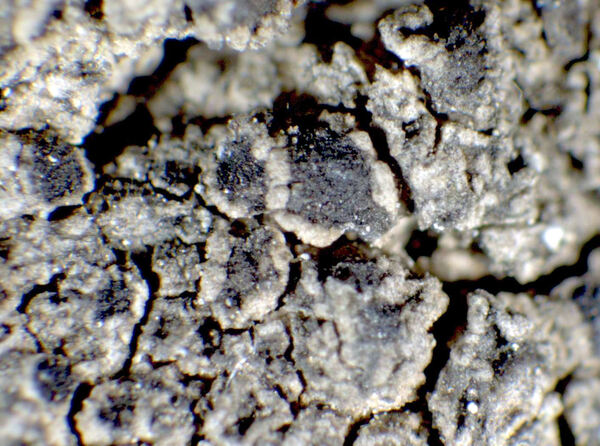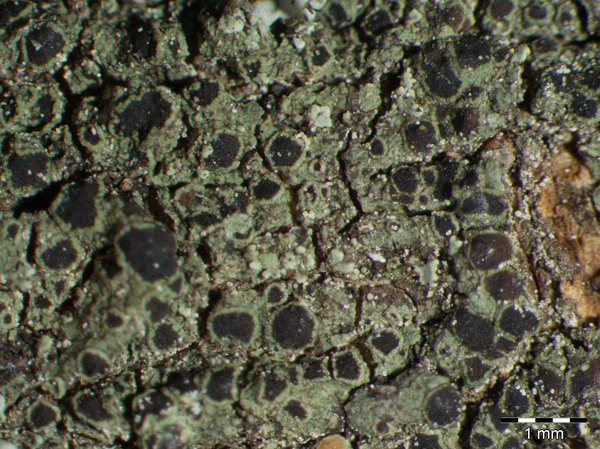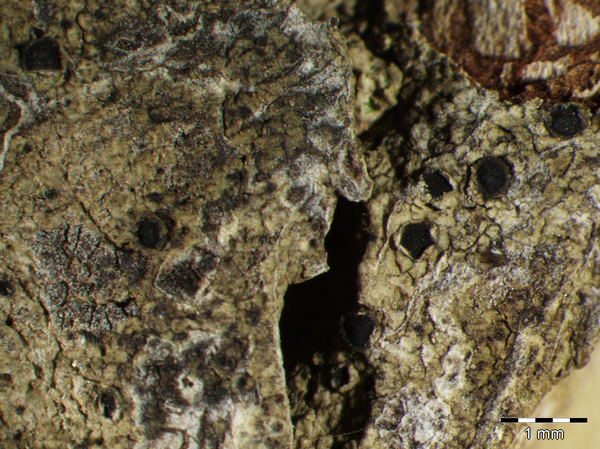Rinodina plana H. Magn.
Acta Horti Gothob., 17: 298, 1947.
Synonyms: Huriopsis plana (H. Magn.) S.Y. Kondr. & Lőkös
Distribution: N - Lig (Rabenhorst Lich. Eur. 508: Giralt & Mayrhofer 1995). C - Sar (Giralt & Mayrhofer 1995, Zedda 2002). S - Si (Nimis & al. 1994, Giralt & Mayrhofer 1995).
Description: Thallus crustose, thinly episubstratic, continuous to rimose-areolate, smooth to verrucose, pale grey in shade-forms to (usually) dark grey or dark grey-brown, forming small patches, often delimited by a brown prothallus. Apothecia lecanorine, subimmersed to adnate, scattered to confluent, (0.3-)0.5-0.8(-1) mm across, with a brown to rarely black, flat to slightly convex disc, and a thick, smooth, persistent thalline margin. Thalline exciple corticate, more or less expanded below in a prosoplectenchymatous tissue, I-; proper exciple indistinct or very thin; epithecium yellowish brown, K-; hymenium colourless, 70-100(-120) µm high; paraphyses to 1.5-2 mm thick at mid-level, the apical cells 3(-4) µm wide; hypothecium pale yellow, 50-70(-100) µm high. Asci 8-spored, narrowly clavate to clavate, the K/I+ blue tholus penetrated by a faintly amyloid apical cushion with parallel or diverging flanks, the wall K/I-, surrounded by a K/I+ blue outer layer, Lecanora-type. Ascospores 1-septate and constricted at septum, brown, ellipsoid, (14-)17-21(-23) x (7-)8-10.5 µm, Physcia-type, with a well-developed torus, the wall warted, the ontogeny of type A (apical wall thickening after septum formation). Photobiont chlorococcoid. Spot tests: K-, C-, KC-, P-, UV-. Chemistry: without lichen substances.Note: an early coloniser of smooth bark, especially of young twigs.
Growth form: Crustose
Substrata: bark
Photobiont: green algae other than Trentepohlia
Reproductive strategy: mainly sexual
Pioneer species
Commonnes-rarity: (info)
Alpine belt: absent
Subalpine belt: absent
Oromediterranean belt: absent
Montane belt: extremely rare
Submediterranean belt: absent
Padanian area: absent
Humid submediterranean belt: rare
Humid mediterranean belt: very rare
Dry mediterranean belt: extremely rare

Predictive model
Herbarium samples
Growth form: Crustose
Substrata: bark
Photobiont: green algae other than Trentepohlia
Reproductive strategy: mainly sexual
Pioneer species
Commonnes-rarity: (info)
Alpine belt: absent
Subalpine belt: absent
Oromediterranean belt: absent
Montane belt: extremely rare
Submediterranean belt: absent
Padanian area: absent
Humid submediterranean belt: rare
Humid mediterranean belt: very rare
Dry mediterranean belt: extremely rare

Predictive model
| Herbarium samples |
 INDEX FUNGORUM
INDEX FUNGORUM
 GBIF
GBIF







